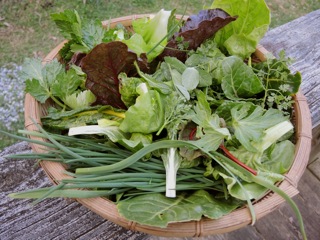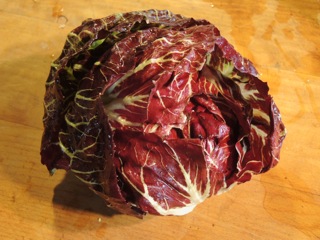By Louise Langsner
 Every year is the year of chicory in my garden. The chicory family is my favorite section of the Seeds from Italy catalog because I like to eat fresh greens all year long, and these plants make it possible. They are easy to grow, beautiful, have wonderfully complex flavor and textures, and are versatile in recipes from soup to salad. I love that they grow quickly and can be harvested as cut-and-come-again salad greens, grow into big satisfying clumps or heads, are hearty enough to over-winter in my zone 6 climate, and re-grow in the spring to provide the earliest greens in the garden. Plus, they have no insect or disease problems.
Every year is the year of chicory in my garden. The chicory family is my favorite section of the Seeds from Italy catalog because I like to eat fresh greens all year long, and these plants make it possible. They are easy to grow, beautiful, have wonderfully complex flavor and textures, and are versatile in recipes from soup to salad. I love that they grow quickly and can be harvested as cut-and-come-again salad greens, grow into big satisfying clumps or heads, are hearty enough to over-winter in my zone 6 climate, and re-grow in the spring to provide the earliest greens in the garden. Plus, they have no insect or disease problems.
Much of my chicory is used in salads, but I also add leaves to soups, use them as wrappers or for stuffing, and sauté them with garlic and chile. I was recently given a chicory-friendly cookbook written by the owners of Franny's, a New York restaurant dedicated to simple, seasonal, Italian food. The book is called Franny's, and includes such fare as Dandelion Greens with a Fried Egg (Chicory Catalogna Pugliese in my version), Escarole Salad with Meyer lemon and Parmigiano Reggiano, Warm Beans with Radicchio and Pancetta (Borlotti beans from the freezer happily met the over-wintered radicchio!), Escarole with Pine Nuts and Red Onion, Puntarelle alla Romana, Cannellini and Escarole Soup, and more. These people love the chicory family.
Chicory Zuccherina di Trieste: I direct seed Zuccherina in early spring and again in late summer for fall harvest. I harvest the tender, mild leaves for salad greens. In fall, I protect the plants with row cover over low hoops to extend the harvest well into winter. They are among the first to start new growth in spring, and I am harvesting the rosettes now.
Misticanza Indivie e Scarole: In spring and again in late summer, I broadcast this mix of seeds into a well-prepared seedbed, aiming for an inch between seeds. Some of the seedlings will be transplanted to another bed to grow into full-sized plants. The rest are harvested first by thinning and then by cutting for salads. Mature plants, protected with row-covers, may be harvested all winter in a mild year by picking the outer leaves. Escarole is heartier than finely cut endive, but even if the tops freeze the roots will re-grow in spring.

Misticanza Quattro Stagioni: OK. I couldn't resist. Another great mix formesclun. I make succession plantings for cut-and -come-again mesclun from spring until September.
Chicory Selvatica da Campo: I fell in love with this variety in Southern Italy, where it is braised with olive oil and garlic and eaten with beans. I planted in August for harvest in October. I am hoping to eat new young leaves soon. This is great with a puree of dried fava beans.
Chicory Catalogna Brindisina: I absolutely love the thick, crunch stems of this variety (and memories of Brindisi). I direct seed this chicory the first week of August to get mature plants in October. Leaves may be harvested for salad earlier. I cover the plants with row cover over hoops and was able to harvest through December. The roots are sending up new growth for spring.
Chicory Catalogna Pugliese:Another "dandelion leaf" variety for fall and winter harvest, direct seeded in early August. Young leaves are used in salads; older leaves are great in soups and gratin of white beans.
Chicory Pan di Zucchero: This variety is amazingly sweet and mild--the backbone of my winter salads. The Franchi strain makes the largest and most uniform heads I have ever grown. I used to direct seed and transplant from the bed, but find it more reliable to start the seed in cell flats so that the roots are less disturbed. I plant in late July and transplant in mid-August, spacing about 10 inches apart, to get mature heads by late October. Pan di Zucchero is very hearty and will continue growth even as the weather turns cold. I protect the plants with heavy weight row cover and add a second layer when temperatures fall below 20 degrees. The heads also keep very well in the refrigerator.

Radicchio Variegata di Lusia Early: I got this because I misread the name as Luisa--thought it was named for me! I planted the seed in late July in cell flats to avoid transplant shock and set the seedlings out spaced about 8 inches apart. They headed up beautifully in late October. Some were small, so I left them under two layers of row cover supported by low hoops. We had a very cold winter and many snowfalls, so I didn't check on them until the end of February. The heads had filled out and were perfect! Just a few frosted outer leaves. The plants that had been harvested in the fall made new growth ready to eat in March.
Radicchio Palla Rossa: I seeded Rossa in cell flats in late July, transplanted in mid-august, and got well filled heads in early November. Again, those that were slow were covered and left over winter. They grew beautifully and tasted mild and sweet.
You might wonder how I am able to eat so much chicory. My tai chi teacher is a world class leaf-eater. I can take her garbage bags full of greens, and she will eat them all!
Louise Langsner
Marshall, NC
